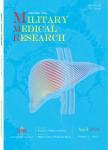Characteristics of short double stranded RNA against hepatitis C virus: a literature-based analysis
Characteristics of short double stranded RNA against hepatitis C virus: a literature-based analysis作者机构:Department of Epidemiology Institute of Navy Medicine
出 版 物:《Journal of Medical Colleges of PLA(China)》 (中国人民解放军军医大学学报(英文版))
年 卷 期:2013年第28卷第3期
页 面:139-151页
学科分类:1004[医学-公共卫生与预防医学(可授医学、理学学位)] 100401[医学-流行病与卫生统计学] 10[医学]
基 金:Supported by Grants from the Committee of Science and Technology of Shanghai China (No.10ZR1413100 and No.114119a1400)
主 题:Hepatitis C virus Short double stranded RNA, Small interfering RNA Short hairpin RNA RNA interference
摘 要:Objective: To describe the characteristics of short interfering double stranded RNA (dsRNA) against hepatitis C virus (HCV) and to fred out the determining factors in design for desirable inhibitory efficacy. Methods: The data were collected and analyzed by retrieval of 229 published short dsRNAs designed for degradation ofHCV RNA. Results: Statistical analyses showed that the most frequently involved short dsRNAs were directing against 5'NTR/core and genotype lb, accounting for 64.2% and 69.9%, respectively. Inhibitory efficacy varied with the structural characteristics of short dsRNAs, of which the most potential were those directed against HCV core region with inhibitory efficacy of 70.2%. Moreover, the mean inhibitory efficacy of short dsRNAs with GC contents from 30% to 52% was higher than that of those with GC contents out of this range. Conclusion: Based on this pooled data in a relatively large sample, the present results provided clues to design for short dsRNAs with more potent inhibitory efficacy.



